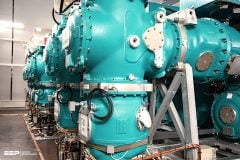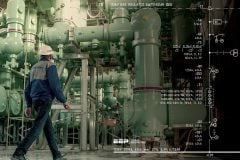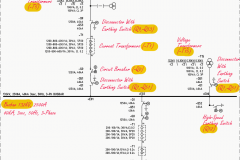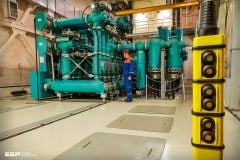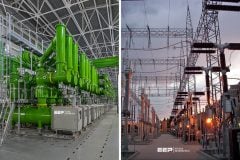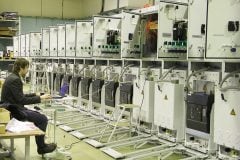What to Expect From Operating Old GIS
Every new GIS switchgear eventually gets old and obsolete at the end of its lifetime. Problems with GIS, as with every other switchgear type, typically start after the midpoint of the lifecycle. This is the point at which the end user expects to receive support from the GIS manufacturer. The aim of this article is to provide an overview of what an end user can and what cannot expect from a manufacturer regarding the support for an old GIS and what options for GIS life extension he has.

Given that the GIS is an integrated system of functional components, a residual life decision cannot be made solely by considering individual parts, such as circuit breakers or disconnectors. The evaluation must encompass the entire GIS installation.
Studies of several GIS installations operational for over 40 years reveal significant life expectancy; nonetheless, identifying the end of life is a multifaceted issue.
This technical article references the “Manufacturer” and “End User” of GIS. However, due to the significant changes in the electrical industry, the original manufacturer and, indeed, the End User may differ from those present at the time of the equipment’s initial installation.
These alterations may lead to the loss of technical information and expertise, hence complicating the evaluation of residual life and potential methods for its extension.
- Support for an Old Discontinued GIS
- What are the Options For GIS Life Extension?
- Attachment (PDF) 🔗 Download ‘Detailed Design and Analysis of GIS for Electrified Railway System’
1. Support for an Old Discontinued GIS
Normally, the end customers anticipate support for the recently discontinued Gas-Insulated Switchgear (GIS). Manufacturers frequently offer support throughout the equipment’s service life. The subsequent paragraphs provide examples of potentially available services.
The manufacturer’s problem in delivering this assistance lies in balancing the prolonged lifespan of the GIS with the industrial trend of reducing product life cycles.
Given that manufacturers’ product obligations may have evolved over the lifespan of the installed equipment, it is advisable for end users’ asset management policies to include the maintenance of up-to-date contacts for service and spare parts.
1.1 Knowledge, Expertise and Skills
The knowledge and skill of both end user and manufacturer personnel regarding the equipment must be taken into account. Many of end users have reduced their workforce by outsourcing a significant portion of maintenance tasks to contractors or manufacturers, resulting in a loss of essential knowledge.
Manufacturers may have lost proficiency as new equipment ranges are launched, resulting in limited familiarity with earlier equipment kinds. The consolidation of manufacturing into a restricted number of plants, accompanied by the closure of some, has been another contributing factor.
Both consumers and manufacturers usually experience a loss of professionals knowledgeable about older technology owing to retirement. The inherent reliability of GIS has simultaneously extended maintenance intervals and decreased the skill levels required for maintenance activities. Retraining may be necessary prior to conducting repairs on antiquated equipment.
Maintaining knowledge of GIS over one’s career is a significant difficulty for both end users and manufacturers in the future. An inadequate level of expertise may result in the premature obsolescence of the GIS before the technical or operational factors need it.
Figure 1 – Substation engineers preparing GIS extension


1.2 Problems With Spare Parts After 10-15 Years?
The integrated nature of GIS necessitates that all components be supplied from a single provider, hence elevating the significance of spare parts availability.
The situation gets worse by the decreased need for spare parts, challenges in testing and recertification, particular storage requirements, and typically extended manufacturing lead times.
1.2.1 Availability of Spare Parts
Manufacturers often provide spare parts for a minimum of 10 to 15 years following the end of production of that GIS type, and frequently for an extended duration. Perhaps after this period, it may still be feasible to get spare parts, but at a premium cost and with extended lead times, owing to reduced or perhaps singular production batches and the availability of raw materials.
Consumable spare parts (e.g., seals, desiccants) are perpetually accessible for maintenance and repair. If a consumable item becomes unavailable, the manufacturer might offer or suggest appropriate substitutes.
Figure 2 – Gas-insulated switchgear spare parts stock


1.2.2 Spare Parts Holding Policy
Diverse alternatives are available for spare parts. Some end users acquire extra parts alongside the primary equipment; nevertheless, the storage of these spares frequently poses a challenge, resulting in many becoming unusable when needed. Others establish agreements with the original equipment manufacturers to retain spare parts on their behalf.
Certain end user groups establish agreements to maintain a shared reserve of spare parts, thereby offering reciprocal assistance. Occasionally, these pooled spares are kept at the GIS manufacturer’s facility. This specific method may be suitable at the conclusion of the manufacturing of a certain form of GIS.
This facilitates cost-sharing and enhances the availability of a diverse array of components.
Provided the circumstances permit, the deconstruction of an obsolete GIS may create the chance to utilize the components or bays as sources for spare parts or additions, if relevant.

